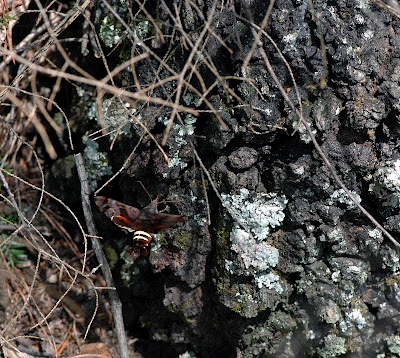During my recent hike at Conkle's Hollow, I noticed a couple of Scarlet Oak trees had broken and fallen around the trail. The trunks were cracked and oozing sap. The pungent odor of rotting wood was very noticeable. If it wasn't for the fact I was trying to cover a lot of ground, I could have stayed in one spot and watched the large variety on insects come in to feed. There were a lot of Red Admiral butterflies coming in to these trees. Click on the picture and try to find them all. I'll let you know how many are visible in a minute.
Populations in the insect world fluctuate readily each year. During the past two seasons, the Buckeye butterfly was found in higher numbers than usual. Usually at this time one sees lots of Mourning Cloaks, Tiger Swallowtails, and Zebra Swallowtails. To me their numbers are down. Not so with this years Red Admirals, Vanessa atalanta. There have been population explosions throughout the midwest. Once again, if you click on the picture, you can see the proboscis or tongue probing the tree wound.
Out of all the Brush-footed Butterflies (Nymphalidae), some say the Painted Ladies have the most beautiful looking patterns on the back of the wings. To me the Red Admiral is every bit as intricately marked.
Backside not withstanding, the Red Admiral is one of our showier butterflies. When such an easy meal of sugary sap is in such abundance, many of these insects were easy to approach. The first picture contains 10 of them, 8 left 2 right, although I counted at least 20 feeding there at one time.
Another Nymphalid butterfly on the scene was this Question Mark, Polygonia interrogationis. This group of butterflies are often referred to as Anglewings. Two common species occur in our area, the Comma and Question Mark. The names come from the silvery marks found on the back of the hindwing.
I have respect for Bees and Wasps, so this Paper Wasp didn't like it one bit that I was getting so close, and he made sure I knew it. Result, blurred and grainy photo! I used to catch moths in a bait trap using fermented beer and rotting fruit. Nothing I hate worse than seeing your trap full of Paper Wasps and Yellow Jackets instead of moths!
A lot of the participants weren't as colorful as butterflies, but it's still amazing to see the variety in every crevice. Here a bottle fly and black ant were literally pushing each other away from the sap outcrop.
If there's the smell of something rotten in the air, you can bet flies of all types will be around. Related to House Flies, this is a member of the Anthomyiidae family. Often called Root-maggot Flies, some adults like this are saprophytic.
These two were doing a dance for each other. The heavily mottled wings and gray speckled body led me to Pseudotephritis vau, a Picture-winged Fly. According to the wing venation, these 'should' be True Fruit Flies from the family Tephritidae. So why was I fooled? Look at the genus name. Pseudotephritis translates to "false fruit fly".
All I see is a blur. Well, um, ya. Let me explain. A Satyr butterfly came in. It flew like the common Little Wood Satyr, but I noticed something different. Anxious to get a pic, I had one shot, and he flew. Should have been more patient. It's not a Little Wood, but the Gemmed Satyr, Cyllopsis gemma. In Ohio they are found only in the S.E. part of the state. Gemmed Satyrs have a small gray patch under the hindwing lined in a small row of black dots. Had this been new to the area, there is enough photographic proof to count this as a record. Sometimes lousy photos still may contain important information.
Right after I missed the Satyr, this Hawkmoth flew in, hovering just long enough to test the saps flavor. Once again, I only had time for one click. Yippie, I got him! This is the Nessus Sphinx, Amphion floridensis. The chocolate forewings and orange hindwings are cool enough, but the neat part is the double yellow striped abdomen, and the tail-like hair projections on the end of the abdomen. The Nessus is a day flyer and often can be seen nectaring on flowers.











Its scary sometimes to think about the possibility of any and all possible species that rely on other organisms for life die out, because we have affected their habitats, in the end leaving the organisms alive now that need them, helpless.
ReplyDelete-Samudaworth Tree Service